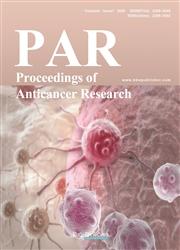Clinical Value of Peripheral Blood Circulating Tumor Cells and Cell-Free DNA Combined Detection in Triple-Negative Breast Cancer
引用次数: 0
Abstract
Objective: To determine the clinical value of combined detection of circulating tumor cells (CTCs) and cell-free DNA (cfDNA) in peripheral blood of patients with triple-negative breast cancer. Method: 41 patients with breast cancer admitted to the First Central Hospital of Baoding from January 2020 to December 2021 were selected and recruited into the experimental group, 42 patients with benign breast cancer admitted during the same period were recruited into the conditional control group, and 41 healthy patients admitted during the same period were recruited into the blank control group. The positive rate of peripheral blood CTCs, the level of cfDNA, and the diagnostic efficacy of peripheral blood CTCs, cfDNA alone and the combination thereof for breast cancer were analyzed. Result: The positive rates of peripheral blood CTCs in the experimental group, the conditional control group, and the blank control group were 43.90%, 11.90%, and 9.74%, respectively, and there was significant difference among the groups. The levels of cfDNA in peripheral blood of the experimental group, the conditional control group, and the blank control group were 0.26 ± 0.08 bp, 0.17 ± 0.03 bp, and 0.15 ± 0.04 bp, respectively, which were statistically significant. The detection levels of 100 bp hTERT/ng·ml-1 and 241 bp hTERT/ng·ml-1 in the experimental group were significantly higher than those in the conditional control group and the blank control group. The accuracy of peripheral blood CTCs detection in the three groups was 66.21%, the accuracy of cfDA241 bp / 100 bp hTERT detection was 80.41%, and the accuracy of combined detection of peripheral blood CTCs and cfDNA was 94.03%. Conclusion: The clinical application of peripheral blood CTCs combined with cfDNA level detection can increase detection accuracy, provide data support for clinicians, and improve the clinical diagnostic effect of triple-negative breast cancer.外周血循环肿瘤细胞和无细胞DNA联合检测在癌症三阴性中的临床价值
目的:探讨癌症三阴性患者外周血循环肿瘤细胞(CTC)和无细胞DNA(cfDNA)联合检测的临床价值。方法:选取保定市第一中心医院2020年1月至2021年12月收治的41例癌症患者为实验组,同期收治的42例癌症良性乳腺患者为条件对照组,同期入院的41名健康患者被纳入空白对照组。分析外周血CTC的阳性率、cfDNA水平以及外周血CTL、单独cfDNA及其组合对乳腺癌症的诊断效果。结果:实验组、条件对照组和空白对照组外周血CTC阳性率分别为43.90%、11.90%和9.74%,各组间差异有统计学意义。实验组、条件对照组和空白对照组的外周血cfDNA水平分别为0.26±0.08bp、0.17±0.03bp和0.15±0.04bp,具有统计学意义。实验组100bp hTERT/ng·ml-1和241bp hTERT/ng·ml-2的检测水平显著高于条件对照组和空白对照组。三组外周血CTC检测的准确率为66.21%,cfDA241bp/100bp hTERT检测的准确度为80.41%,外周血CTCs和cfDNA联合检测的准确性为94.03%,提高癌症三阴性的临床诊断效果。
本文章由计算机程序翻译,如有差异,请以英文原文为准。
求助全文
约1分钟内获得全文
求助全文

 求助内容:
求助内容: 应助结果提醒方式:
应助结果提醒方式:


